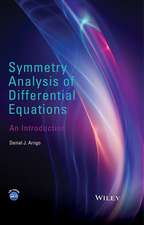Phase Transition Dynamics
Autor Tian Ma, Shouhong Wangen Limba Engleză Hardback – 20 noi 2019
This book is an introduction to a comprehensive and unified dynamic transition theory for dissipative systems and to applications of the theory to a range of problems in the nonlinear sciences. The main objectives of this book are to introduce a general principle of dynamic transitions for dissipative systems, to establish a systematic dynamic transition theory, and to explore the physical implications of applications of the theory to a range of problems in the nonlinear sciences. The basic philosophy of the theory is to search for a complete set of transition states, and the general principle states that dynamic transitions of all dissipative systems can be classified into three categories: continuous, catastrophic and random. The audience for this book includes advanced graduate students and researchers in mathematics and physics as well as in other related fields.
This second edition introduces a unified theory for topological phase transitions, provides a first-principle approach to statistical and quantum physics, and offers a microscopic mechanism of quantum condensates (Bose-Einstein condensation, superfluidity, and superconductivity).
Reviews of first edition:
“The goals of this interesting book are to derive a general principle of dynamic transitions for dissipative systems and to establish a systematic dynamic transition theory for a wide range of problems in the nonlinear sciences. … The intended audience for this book includes students and researchers working on nonlinear problems in physics, meteorology, oceanography, biology, chemistry, and the social sciences.” (Carlo Bianca, Mathematical Reviews, December, 2014)
“This is a clearly written book on numerous types of phase transitions taken in a broad sense when a dynamical dissipative system transforms from one physical state into another. … The book is a very useful literature not only for the professionals in the field of dynamic systems and phase transitions but also for graduate students due to its interdisciplinary coverage and state-of-the-art level.” (Vladimir Čadež, zbMATH, Vol. 1285, 2014)
This second edition introduces a unified theory for topological phase transitions, provides a first-principle approach to statistical and quantum physics, and offers a microscopic mechanism of quantum condensates (Bose-Einstein condensation, superfluidity, and superconductivity).
Reviews of first edition:
“The goals of this interesting book are to derive a general principle of dynamic transitions for dissipative systems and to establish a systematic dynamic transition theory for a wide range of problems in the nonlinear sciences. … The intended audience for this book includes students and researchers working on nonlinear problems in physics, meteorology, oceanography, biology, chemistry, and the social sciences.” (Carlo Bianca, Mathematical Reviews, December, 2014)
“This is a clearly written book on numerous types of phase transitions taken in a broad sense when a dynamical dissipative system transforms from one physical state into another. … The book is a very useful literature not only for the professionals in the field of dynamic systems and phase transitions but also for graduate students due to its interdisciplinary coverage and state-of-the-art level.” (Vladimir Čadež, zbMATH, Vol. 1285, 2014)
| Toate formatele și edițiile | Preț | Express |
|---|---|---|
| Paperback (2) | 710.75 lei 43-57 zile | |
| Springer – 22 aug 2016 | 710.75 lei 43-57 zile | |
| Springer International Publishing – 20 noi 2020 | 1131.25 lei 43-57 zile | |
| Hardback (2) | 717.14 lei 38-44 zile | |
| Springer – 9 noi 2013 | 717.14 lei 38-44 zile | |
| Springer International Publishing – 20 noi 2019 | 1137.73 lei 43-57 zile |
Preț: 1137.73 lei
Preț vechi: 1387.47 lei
-18% Nou
Puncte Express: 1707
Preț estimativ în valută:
217.77€ • 236.63$ • 183.05£
217.77€ • 236.63$ • 183.05£
Carte tipărită la comandă
Livrare economică 21 aprilie-05 mai
Preluare comenzi: 021 569.72.76
Specificații
ISBN-13: 9783030292591
ISBN-10: 3030292592
Pagini: 757
Ilustrații: XXXI, 757 p. 196 illus., 10 illus. in color.
Dimensiuni: 155 x 235 mm
Greutate: 1.28 kg
Ediția:2nd ed. 2019
Editura: Springer International Publishing
Colecția Springer
Locul publicării:Cham, Switzerland
ISBN-10: 3030292592
Pagini: 757
Ilustrații: XXXI, 757 p. 196 illus., 10 illus. in color.
Dimensiuni: 155 x 235 mm
Greutate: 1.28 kg
Ediția:2nd ed. 2019
Editura: Springer International Publishing
Colecția Springer
Locul publicării:Cham, Switzerland
Cuprins
Introduction to Dynamic Transitions.- Dynamic Transition Theory.- Equilibrium Phase Transitions in Statistical Physics.- Fluid Dynamics.- Geophysical Fluid Dynamics and Climate Dynamics.- Dynamical Transitions in Chemistry and Biology.- Fundamental Principles of Statistical and Quantum Physics.- Quantum Mechanism of Condensates and High Tc Superconductivity.- Topological Phase Transitions.
Textul de pe ultima copertă
This book is an introduction to a comprehensive and unified dynamic transition theory for dissipative systems and to applications of the theory to a range of problems in the nonlinear sciences. The main objectives of this book are to introduce a general principle of dynamic transitions for dissipative systems, to establish a systematic dynamic transition theory, and to explore the physical implications of applications of the theory to a range of problems in the nonlinear sciences. The basic philosophy of the theory is to search for a complete set of transition states, and the general principle states that dynamic transitions of all dissipative systems can be classified into three categories: continuous, catastrophic and random. The audience for this book includes advanced graduate students and researchers in mathematics and physics as well as in other related fields.
This second edition introduces a unified theory for topological phase transitions, provides a first-principle approach to statistical and quantum physics, and offers a microscopic mechanism of quantum condensates (Bose-Einstein condensation, superfluidity, and superconductivity).
Reviews of first edition:
“The goals of this interesting book are to derive a general principle of dynamic transitions for dissipative systems and to establish a systematic dynamic transition theory for a wide range of problems in the nonlinear sciences. … The intended audience for this book includes students and researchers working on nonlinear problems in physics, meteorology, oceanography, biology, chemistry, and the social sciences.” (Carlo Bianca, Mathematical Reviews, December, 2014)
“This is a clearly written book on numerous types of phase transitions taken in a broad sense when a dynamical dissipative system transforms from one physical state into another. … The book is a very useful literature not only for the professionals in the field of dynamic systems and phase transitions butalso for graduate students due to its interdisciplinary coverage and state-of-the-art level.” (Vladimir Čadež, zbMATH, Vol. 1285, 2014)
This second edition introduces a unified theory for topological phase transitions, provides a first-principle approach to statistical and quantum physics, and offers a microscopic mechanism of quantum condensates (Bose-Einstein condensation, superfluidity, and superconductivity).
Reviews of first edition:
“The goals of this interesting book are to derive a general principle of dynamic transitions for dissipative systems and to establish a systematic dynamic transition theory for a wide range of problems in the nonlinear sciences. … The intended audience for this book includes students and researchers working on nonlinear problems in physics, meteorology, oceanography, biology, chemistry, and the social sciences.” (Carlo Bianca, Mathematical Reviews, December, 2014)
“This is a clearly written book on numerous types of phase transitions taken in a broad sense when a dynamical dissipative system transforms from one physical state into another. … The book is a very useful literature not only for the professionals in the field of dynamic systems and phase transitions butalso for graduate students due to its interdisciplinary coverage and state-of-the-art level.” (Vladimir Čadež, zbMATH, Vol. 1285, 2014)
Caracteristici
Theory and methods are applicable to a wide range of scientific problems Provides a thorough introduction to dynamic transition theory for nonlinear partial differential equations Mathematical discussion of dynamic transition theory is developed with attention to physics
Recenzii
From
the
book
reviews:
“The goals of this interesting book are to derive a general principle of dynamic transitions for dissipative systems and to establish a systematic dynamic transition theory for a wide range of problems in the nonlinear sciences. … The intended audience for this book includes students and researchers working on nonlinear problems in physics, meteorology, oceanography, biology, chemistry, and the social sciences.” (Carlo Bianca, Mathematical Reviews, December, 2014)
“This is a clearly written book on numerous types of phase transitions taken in a broad sense when a dynamical dissipative system transforms from one physical state into another. … The book is a very useful literature not only for the professionals in the field of dynamic systems and phase transitions but also for graduate students due to its interdisciplinary coverage and state-of-the-art level.” (Vladimir Čadež, zbMATH, Vol. 1285, 2014)
“The goals of this interesting book are to derive a general principle of dynamic transitions for dissipative systems and to establish a systematic dynamic transition theory for a wide range of problems in the nonlinear sciences. … The intended audience for this book includes students and researchers working on nonlinear problems in physics, meteorology, oceanography, biology, chemistry, and the social sciences.” (Carlo Bianca, Mathematical Reviews, December, 2014)
“This is a clearly written book on numerous types of phase transitions taken in a broad sense when a dynamical dissipative system transforms from one physical state into another. … The book is a very useful literature not only for the professionals in the field of dynamic systems and phase transitions but also for graduate students due to its interdisciplinary coverage and state-of-the-art level.” (Vladimir Čadež, zbMATH, Vol. 1285, 2014)
Descriere
Descriere de la o altă ediție sau format:
This book introduces a general principle of dynamic transitions for dissipative systems, establishes a systematic dynamic transition theory, and explores the physical implications of applications of the theory to a range of problems in the nonlinear sciences.
This book introduces a general principle of dynamic transitions for dissipative systems, establishes a systematic dynamic transition theory, and explores the physical implications of applications of the theory to a range of problems in the nonlinear sciences.













